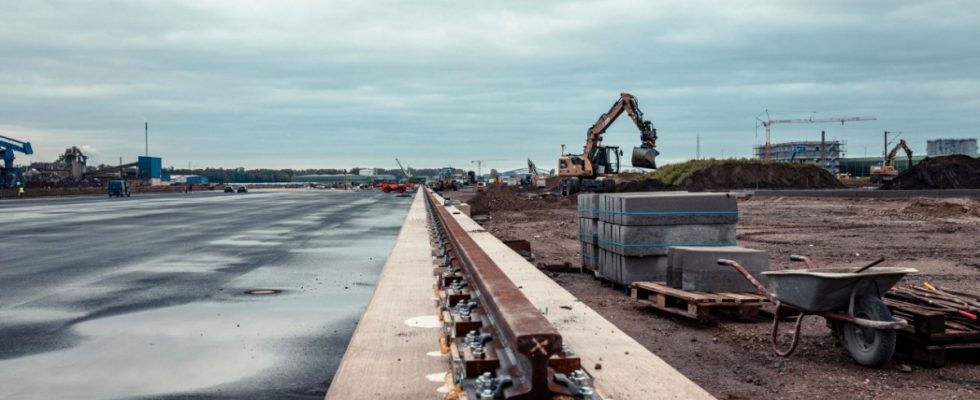A construction worker crouches on a track and welds. A wheel loader drives past. Individual parts for the harbor cranes that will soon be loading and unloading ships here are already lying on the ground: driver’s cabins, long steel beams. The Duisburg Gateway Terminal (DGT), the largest container terminal in a European inland port, i.e. a port on a river, is scheduled to open on this headland next summer.
The port at the mouth of the Ruhr and the Rhine is actually the world’s largest inland port – and will soon be even bigger. Duisburger Hafen AG, or Duisport for short, is investing 125 million euros for this. The company, which is owned by the city and the federal state, is also responding to two challenges with the terminal: the lower water levels of the Rhine and the energy transition.
Because part of the terminal is supposed to have a warehouse for… Up to 900 dangerous goods tank containers are created. These are tanks that can be transported like containers. There is a lot of chemical industry along the Rhine, for example in Leverkusen or Ludwigshafen. Companies like Covestro have many raw materials and products delivered or picked up by inland waterway vessels. But when the water level is very low, as it is again in summer, the ships cannot be fully loaded or, in the worst case, cannot sail at all. The dangerous goods tank farm is intended to offer an alternative.
“Between Rotterdam and the port of Duisburg, the shipping channel is significantly deeper than further south,” says Alexander Garbar, head of corporate development at Duisport. If the Rhine has too little water, inland waterway vessels could at least bring cargo for the chemical industry from the North Sea port of Rotterdam to Duisburg – and there the chemical containers could be loaded onto trains in the new terminal, says the manager.
The amount of coal is falling dramatically
The dangerous goods area should be ready for use at the end of 2025. A focus of the transshipment here should be on tank containers with the energy source hydrogen or with the precursor ammonia. Climate-friendly produced – so-called green – hydrogen is a pillar of the energy transition. In the future, the molecules will replace natural gas, oil and coal in chemical factories and steelworks, in ship engines and power plants. Large customers such as Thyssenkrupp’s steelworks in Duisburg will be supplied with hydrogen via a pipeline. “But for smaller customers, tank containers with hydrogen that are delivered to Duisburg by ship are a good option,” says port manager Garbar.
In addition to Duisport, the co-owners of the new terminal are the terminal operator PSA from Singapore, the Dutch shipping company HTS and the logistics group Hupac. Initially, the Chinese state-owned company Cosco was also part of the group. The company’s entry into a terminal in the Port of Hamburg is highly controversial. In Duisburg, however, the Chinese said goodbye to the consortium in the summer of 2022.
Port manager Alexander Garbar at the construction site: “We will be self-sufficient and will not need a power connection,” he says.
(Photo: Eugen Shkolnikov)
The terminal is being built on the Coal Island, a port area where coal was previously transshipped. The climate-friendly hydrogen will be stored in the same place as the climate killer coal used to be. The operator Duisport notices from its figures that coal no longer has a future: “At its peak we handled 20 million tons per year, recently it was just 700,000 tons,” says Garbar.
In addition to the container terminal, Duisport wants build a new tank farm, together with the Dutch terminal operator Koole. Tank inland vessels should be able to unload climate-friendly ammonia there. The chemical industry needs a lot of ammonia, but so far it has mostly been produced from natural gas, which will no longer be possible in the future for the sake of the climate. The ammonia can also be further processed into green hydrogen.
Hydrogen will also power the cranes and other machines at the new container terminal. Because Duisport wants to operate this in a climate-neutral manner. Fuel cells and a combined heat and power plant are intended to generate the necessary electricity from green hydrogen, as well as solar systems. “We will be self-sufficient and will not need a power connection,” says Gardar. “But of course we still have one.”

